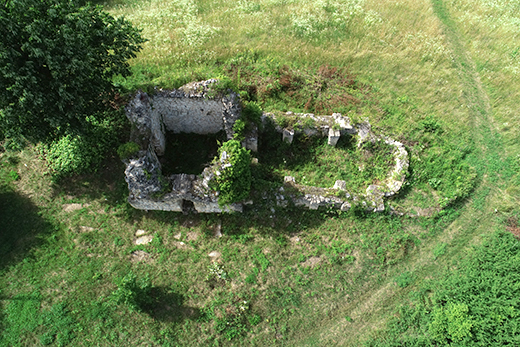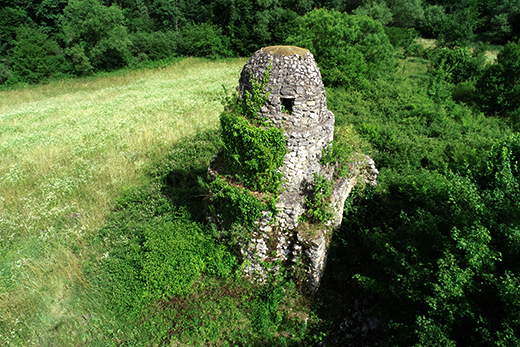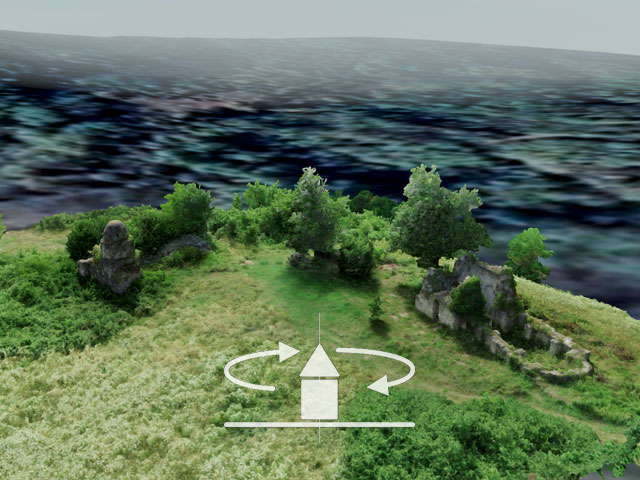Velimir's Castles
Protected cultural monument of great significance, listed as SK 254 with the Republic Institute for the protection of monuments of cultural heritage.
Velimir's Castles Mionica, Kolubara District
Where is it
Velimirovi dvori (Velimir's Castles) was built in the very centre of the village Ključ, about 4.5 kilometres from Mionica. It was built on a plateau above the river Lepenica which makes a big curve-meander at the foot of the plateau in the shape of a key, which is how the village got its name (key=Ključ).

Research
Archaeological research begun in 1978 by the Institute for the protection of monuments of cultural heritage from Kragujevac.
Systemic archaeological research was done in 1994 and 1995 by the Institute for the protection of monuments of cultural heritage from Valjevo. Excavations were done inside the church and the larder, and about 60 graves were discovered and inside the larder a pit with great quantity of medieval material.
The oldest traces of life in this area date back to prehistoric times, i.e. copper age.
The church, which is the oldest edifice in the complex, is supposed to date from the 15th century. Around the church, a large number of graves from the 16th and 17th century was discovered.
The excavation in the vicinity of the tower-larder confirmed that the edifice belonged to the monastery kitchen and the lodgings.

Description
From former Velimir’s castles the only thing visible in the field today is one dilapidated surrounding wall from eastern and western side about 40 meters long, which used to have a defensive function. A former gate can be observed on the wall.
East from the ramparts there are the walls of the dilapidated church. The church was a one-navy with a narthex in the east. The dimensions of the temple are 12 х 6,7 meters and the added narthex is 7 х 8 meters. There is an added chapel from the north. It was built with hewn stone bound by mortar. The outside façade preserves parts of the painted decoration.
About thirty meters southwest from the temple there is the larder tower. It is actually a rather well-preserved edifice of round base 3 meters in diameter, with walls 0,70 - 0,90 m thick, 6,5 m high, with narrow rectangular widows in the upper part. The opinions on the purpose of this building are divided. One is that it was some kind of hermitage. The other, corroborated by research, is that it was the room for the preparation of food and that it used to belong to the monastery kitchen and lodgings.
Velimir’s castles represent a rare preserved fortified complex of the edifices from the late Middle Ages. This certainly could have been the seat of a feudal property, a fortified court of a local feudal lord about whom the people have preserved some interesting stories.

Folk belief and lore
A folk belief states that Velimir, after whom the castle bears its name, used to be a very rich feudal lord from the retinue of Prince Lazar. He had three sons who all met horrible fates. One son drowned in the river Lepenica, and the other one died on Christmas eve, upon falling from a horseback. Desperate about losing his sons and worried about the fate of the third son, Velimir decided to keep his youngest inside the castle and never let him go outside so that no harm can come to him. He brought food and drink to the tower himself. However, when fate is willing…One day, Velimir brought his son some grapes, from which a snake slithered and bit the unfortunate boy who immediately passed away.
The lore says that Velimir had been met with a curse; namely, Prince Lazar cursed him for not having prepared him a proper welcome during one of his visits to Mionica.
According to another legend, Velimir participated in the battle of Belgrade in 1521 as a sultan’s vassal, and obtained the timar of Ključ with several surrounding villages. There, in Ključ, Velimir built his castle from which he governed the property. According to this legend, his sons renewed the Ribnica monastery near Mionica.
Julka Kuzmanović Cvetkovićarcheologist
